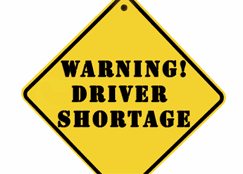By most accounts - but not all – there is a severe truck driver shortage in the US, at least in the long haul sector.
The American Trucking Associations – a large trade association for freight carriers, has been warning that there will likely be a shortage of 160,000 drivers by 2030, up from about 80,000 currently.
Surpply Chain Digest Says...
|
 |
| The vast majority of carrier remain small owner-operator businesses, with 97.4% running fewer than 20 trucks and 91.5% with six trucks or less. |
 |
What do you say? |
| Click here to send us your comments |
 |
| Click here to see reader feedback |
|
And there must be something going on when Walmart ups the pay for its private fleet to as much as $110,000 for first year drivers, as it announced earlier this year. Apparently, it couldn’t attract enough drivers to meet its needs at the previous rookie pay of a still healthy $87,000.
Walmart also made changes to get drivers more nights at home.
In 2021, Walmart hired about 4,500 new drivers, the most in company history, and plans to add over 5,000 in 2022, in part by training between 400 to 800 new drivers through its own driver school.
LTL carrier Yellow Freight says its drivers can make $100,000 per year as well.
But yet, according to the Bureau of Labor Statistics, the average annual wage for US truck drivers is a mere $48,300 per year, at least in 2021.’ And for a job that means long haul drivers are often on the road for many days in a row.
Steve Viscelli, an economic sociologist at the University of Pennsylvania, who has researched the trucking industry for more than 15 years, recently told CNBC.com that “Trucking is a story of bifurcation. There are some excellent jobs and some terrible jobs.”
The CNBC article also nicely describes the tough job driving often be.
Many drivers "work 60-70 hours a week, though a good deal of that time is spent waiting for goods to be loaded or unloaded, and they’re only paid for driving time,” CNBC notes, adding “Many aren’t compensated for overtime, don’t have health care benefits, are paying their own fuel costs and spend days or weeks away from home.”
Part of that description of course, such as paying for gas and no healthcare, applies to independent owner-operators, micro business men and women, and generally not for drivers that are employees of a carrier or private fleet.
But the long stretches on the road and not getting paid while waiting to unload – those are more universal driver issues.
(See More Below)
|
CATEGORY SPONSOR: SOFTEON |
|
|
| |
|
|
As a result, “numerous industry insiders contend that it’s not so much a matter of a driver shortage, but rather an issue of retaining drivers in less-than-desirable jobs,” CNBC notes.
 There was an annnual driver turnover rate of nearly 100% for truckload drivers between 1995 and 2017, according to BLS data. However, it is worth noting that turnover rate does not mean nearly all drivers quit each year. Rather, a high percentage of new drivers last only for a few months or even weeks, sending the overall metric higher. There was an annnual driver turnover rate of nearly 100% for truckload drivers between 1995 and 2017, according to BLS data. However, it is worth noting that turnover rate does not mean nearly all drivers quit each year. Rather, a high percentage of new drivers last only for a few months or even weeks, sending the overall metric higher.
Still, “If you have a business where [more than 90%] of your workforce turned over every year, how efficient or good a business would it be?” Yet it’s commonplace in trucking, because they can’t keep workers. I don’t know how you classify that as a shortage,” Todd Spencer, president of the Owner-Operator Independent Drivers Association (OOIDA), told CNBC.
There are still lots of drivers, millions of them in the US. However, The vast majority of carrier remain small owner-operator businesses, with 97.4% running fewer than 20 trucks and 91.5% with six trucks or less – sometimes just one truck and independent owns.
Some see increasing the number of women drivers as a partial answer. Currently, only about 7% of US drivers are female.
One key issue: concerns and experience with lack of personal safety is the top reason women drivers leave the profession.
Another major issue for drivers overall is what CNBC calls “ unscrupulous lease-purchase agreements” from carriers to independent drivers – something Viscelli has written about in the past.
As a result of these legal arrangements and terms, “drivers can’t keep up payments and default on the agreement,” CNBC says.
Will autonomous trucks be here soon to solve all the troubles?
Likely not for a number of years, and even then are likely to have only a marginal impact.
“If you want to drive a truck, you’ll always have a job,” says Avery Vise, vice president of trucking for research FTR Transportation Intelligence.
Any thoughts on the truck driver situation? Let us know your at the Feedback section below.
|